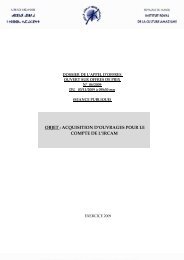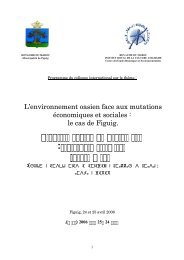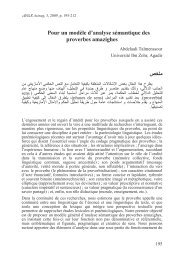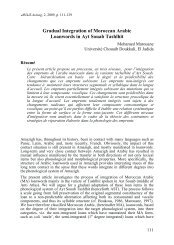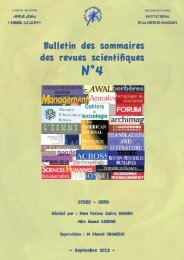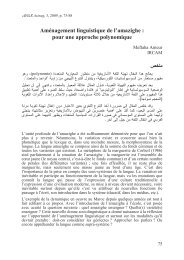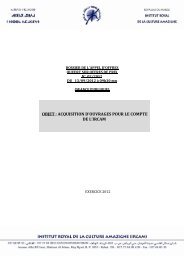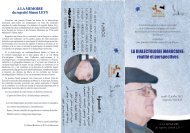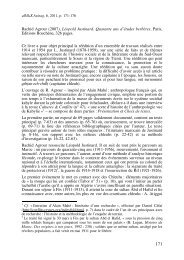La démarche pan-berbère est-elle possible pour une éventuelle ...
La démarche pan-berbère est-elle possible pour une éventuelle ...
La démarche pan-berbère est-elle possible pour une éventuelle ...
You also want an ePaper? Increase the reach of your titles
YUMPU automatically turns print PDFs into web optimized ePapers that Google loves.
Mohand Mahrazi<br />
Castellanos, C. (2003), « Enseignement et standardisation. Les deux urgences de<br />
l’amazigh : la langue comm<strong>une</strong> et l’aménagement néologique », in Actes du<br />
colloque international sur l’amazighe : Education et langues matern<strong>elle</strong>s :<br />
l’exemple de l’amazigh, organisé par la Fondation BMCE, p. 21- 48.<br />
Chaker, S. (1997), « Réflexion sur l’enrichissement du lexique », Tasγunt uselmad,<br />
n o 1, p. 17-18.<br />
Chaker, S. (1996), Manuel de linguistique berbère II. Syntaxe et diachronie, Alger,<br />
ENAG Editions.<br />
Chaker, S. (2000) « Variation dialectale et codification graphique en berbère. Une<br />
notation usu<strong>elle</strong> <strong>pan</strong>-berbère <strong>est</strong>-<strong>elle</strong> <strong>possible</strong> ? », in Codification des langues de<br />
France. Actes du colloque, Paris-INALCO, Mai 2000. L’Harmattan, p. 341-354<br />
Chaker, S. (2005) « Le berbère: de la perspective linguistique à l'enseignement<br />
d'<strong>une</strong> langue matern<strong>elle</strong> », in Rispail M. (dir), <strong>La</strong>ngues matern<strong>elle</strong>: contacts,<br />
variations et enseignements. Les cas de la langue amazighe. Paris, L'Harmattan,<br />
p. 167-175.<br />
Leclerc, J. (1986), <strong>La</strong>ngue et société, Mondia Editeurs.<br />
Nait-Zerrad, K. (2000), « Les systèmes de notation du berbère », in Codification<br />
des langues de France. Actes de colloque, Paris-INALCO, Mai 2000, L’Harmattan,<br />
p. 331-340.<br />
Nait-Zerrad, K. (2005), « Le kabyle langue matern<strong>elle</strong> : variation, standardisation<br />
et enseignement », in Rispaïl M. (dir), <strong>La</strong>ngues matern<strong>elle</strong>: contacts, variations et<br />
enseignements. Les cas de la langue amazighe, Paris, L'Harmattan, p. 241- 245.<br />
Ruffie, J. (1990), « <strong>La</strong> responsabilité des scientifiques », in Bernard Cassen :<br />
Qu<strong>elle</strong>s langues <strong>pour</strong> la science ?, Sciences et société. Paris, <strong>La</strong> Découverte,<br />
p. 210-219.<br />
Sauzet, P. (2000), « Réflexion sur la normalisation linguistique de l’Occitan », in<br />
Caubet D. et al., Codification des langues de France, Actes de colloque, Paris-<br />
INALCO, Mai 2000, L’Harmattan, p. 39-61.<br />
Taïfi, M. (2003), « Si les Berbères ne s’entendent pas, qu’ils s’écrivent ! Pour <strong>une</strong><br />
écriture grammaticale du berbère à usage didactique », in Ameur M. et Boumalk A.<br />
(dir.), Standardisation de l’amazighe, Rabat, Publications de l’IRCAM, p. 30-43.<br />
Taïfi, M. (2004). « On oublie que le berbère <strong>est</strong> <strong>une</strong> langue vivante », entretien<br />
avec le professeur Miloud Taïfi dans le quotidien national Le Matin, 17 janvier,<br />
p. 4.<br />
Tilmatine, M. (1991), « A propos de la néologie en berbère moderne », in Actes du<br />
colloque international de Ghardaïa du 19 et 20 Avril 1991, Publié par GDM. Unité<br />
et diversité de Tamazight. T2.<br />
52




